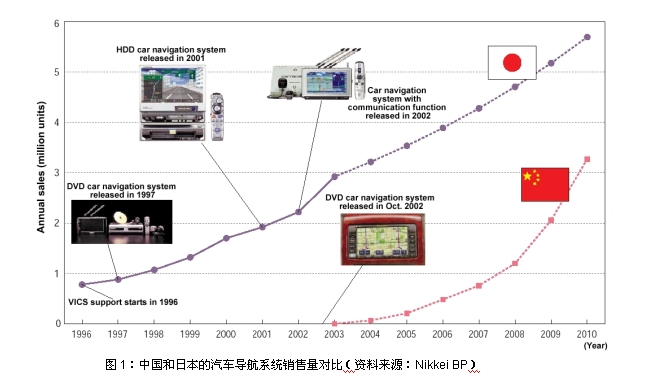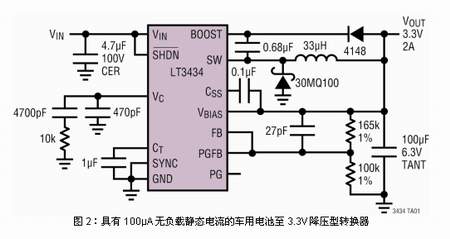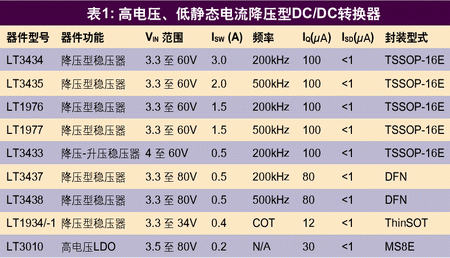In the automotive environment, the wide operating voltage requirements, large transient voltages, and large temperature drifts, the electronic system is facing severe conditions. This article describes how to design multiple power supply voltages under the condition that performance requirements become more demanding. Meet the requirements of different parts of automotive electronic systems.
This article refers to the address: http://
Most mid- to high-end cars currently in production are equipped with DVD-based GPS navigation systems as standard equipment (Figure 1). However, it can be confirmed that if you want to design a power supply for controlling different voltage rails in such systems, the complexity is no less than that of designing a power supply system for notebook computers. A standard car navigation system may have six or more power supplies, including 8V, 5V, 3.3V, 2.5V, 1.5V, and 1.2V. The 8V power supply is used to power the DVD motor that rotates the disc; this often requires up to 2A of peak current. The 5V and 3.3V rails are usually system buses and typically require 2A to 3A of current. The 2.5V rail is used for memory and I/O, so a current of 1A to 2A is sufficient. The 1.5V and 1.2V rails are used to provide the CPU core and DSP core voltage, respectively. The power levels of these two power rails are generally between 3W and 5W.
At the same time, as the number of components in these systems increases, the available space becomes increasingly narrow. Therefore, in view of the fact that all of the actual radiators are so large that they are inconvenient to install, the importance of conversion efficiency becomes more prominent due to space constraints and operating temperature range requirements. Simply using a linear regulator to generate these system voltages is no longer feasible at low output voltages and moderate current levels above a few hundred milliamps. Therefore, in the past few years, switching regulators have been gradually replacing linear regulators mainly due to thermal limitations. The advantages of switching power supplies include higher efficiency and smaller footprint, which makes the increase in complexity and EMI issues less important.
If you consider the switching regulator limitations in a car navigation system, you will need to have the following features and characteristics:
Wide input working range
Good efficiency over a wide load range
Low quiescent current during normal operation, standby, and shutdown
Low thermal resistance
Lowest noise and EMI emissions
Let's examine these basic capabilities in more detail:
1. Wide input working range

Figure 1: Most mid- to high-end cars are equipped with DVD-based GPS navigation systems as standard equipment.
Any switching regulator needs to be specified to operate over a wide input voltage range of 3V to 60V to ensure conditions for "cold start" and "load dump". It also has the added advantage of enabling these automotive systems to operate at 14V or 42V. Moreover, the 60V rated voltage provides a good margin for 14V systems that are typically clamped to 36V to 40V. In addition, the 60V rated voltage allows the device to be used in future 42V systems. This means that a design made today for a 14V system can be easily upgraded for the 42V system without any major redesign work.

2. Efficiency
In most automotive systems, efficient power conversion over a wide load range is essential. For example, in a load range of 10 mA to 2.5 A, the power conversion efficiency of a 5V output is required to be around 85%. At high currents, the internal switch needs to have good saturation, typically 0.1Ω at 3A. In order to improve light load efficiency, it is necessary to reduce the drive current or to make it proportional to the load current. Moreover, the power used for the internal control circuitry can be provided by an offset pin that can be powered by the output. This is due to the power conversion efficiency of a buck converter. Since the bias current is absorbed from the output (rather than the input), the input supply current required by the control circuit is reduced by the ratio of the output to the input voltage. For example, a 100μA output current at 3.3V requires only a 30μA average input current at 12V. This minimizes the input current required by the control circuitry and increases the efficiency level at light loads.

Table 1: High-Voltage, Low Quiescent Current Step-Down DC/DC Converters
3. Low quiescent current
There are many applications in automotive systems that require continuous power supply even when the vehicle is in a stopped state. A key requirement for these applications is low quiescent current. The device will operate in normal continuous switching mode until the output current drops below approximately 100mA. Below this current level, the switching regulator must skip several pulses to maintain regulation. The regulator enters sleep mode between pulses, at which point only some of the internal circuitry is powered. Under light load current conditions, the switching regulator needs to automatically switch to burst mode operation. In this mode, the quiescent current should be reduced to less than 100μA for a 12V to 3.3V converter. In sleep mode, the internal reference and power good circuitry will remain operational to monitor the output voltage. In shutdown mode, the quiescent current should be less than 1μA.
4. Low thermal resistance
Ideally, the junction-to-case thermal resistance should be low. If the back of the device is bare copper and soldered to the surface of the PC board, the PC board can be used to conduct heat away from the device. At present, a four-layer circuit board having an internal power plane is commonly used to achieve a thermal resistance of about 40 ° C / W. High ambient temperature applications with good thermal conduction to the metal casing can achieve typical junction-to-case thermal resistance values ​​approaching 10 °C/W. This helps to extend the operating temperature range.
5. Considerations regarding noise and EMI
Although switching regulators generate more noise than linear regulators, they are much more efficient than the latter. In many sensitive applications it has been demonstrated that noise and EMI levels can be controlled as long as the switching power supply operates in a predictable manner. If the switching regulator is switching at a constant frequency in normal mode and the switching pulse edges are clean and predictable (no overshoot or high frequency ringing), EMI will be minimized. A small, compact package with a low footprint and high operating frequency minimizes EMI emissions. In addition, input and output ripple (which are additional sources of noise in the system) can be minimized if the regulator can be used with low ESR ceramic capacitors.
Obviously, the design and development of such switching regulators is not simple. However, in the past few years, Linear Technology has been working on this high-voltage DC/DC converter and has a product library designed to meet these requirements and an increasing number of products ( Table 1).
The LT3434 is an example of such a recent DC/DC converter that is part of a growing family of monolithic step-down switching regulators capable of handling 60V. This device solves many of the problems faced by the above car navigation applications. The LT3434 operates over a wide input voltage range of 3.3V to 60V (Figure 2). It provides high efficiency at load currents up to 2.5A. The reference accuracy is ±2% for all voltage, load and temperature conditions.
Since the device has Burst Mode operation, its quiescent current is less than 100μA for 12V to 3.3V applications. The device is available in a small outline flat TSSOP package with very low thermal resistance for a small footprint design. Finally, it uses a current-mode topology designed to achieve superior transient response and simple compensation, and uses a patented circuit that maintains a constant peak switching current at all duty cycles. The switching frequency is constant at 200kHz and the device can be synchronized to a higher frequency. It provides tight voltage regulation over the automotive temperature range and features Power Good/Reset, Soft Start and UVLO (Undervoltage Lockout). The circuit provides a rugged, efficient, small footprint solution at current levels up to 2.5A.
Summary of this article
Despite the complexity of car navigation systems and the high performance of their analog DC/DC converters, you don't need to panic. Companies such as Linear Technology are introducing a "new wave" regulator that combines many key features that are necessary for system engineers to reduce power supply design effort and severity.
Folding, easy to use and store. Ideal for learning, reading and working;
Comes with 3014/2835LEDs, high performance, energy saving and environment friendly;
360°all-direction illumination and touch the switch to adjust lightness of the lamp;
Surface light source, no flicker, soft light;
The Dimmable Table Lamp Ra>80, very close to nature light.
Energy Efficient LED Desk Lamp that will reduce energy spending by 75%
Desk Lamp that is pleasant on the eyes with flicker-free lighting for reading, working, and studying
Desk lamps are also the perfect solution if you are a student and need help finishing your homework at night.
Dimmable Table Lamp
Dimmable Table Lamp,LED Dimmable Table Lamp,Dimmable Decorative Table Lamp
Shenzhen Superlight Technology Co., Ltd. , https://www.superlighttech.com